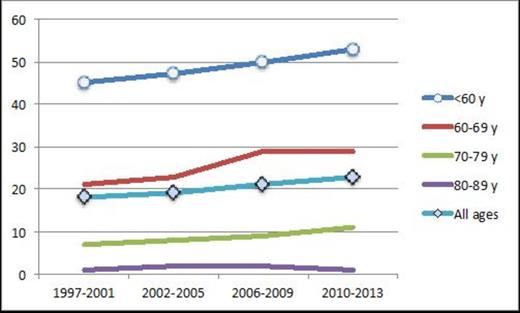Abstract
Despite improved diagnostics and better understanding of AML biology, the basic chemotherapy has remained unchanged for decades, with no progress in outcome. In Sweden, national guidelines for the comprehensive management of AML were implemented in 2006, containing primary therapy with daunorubicin 60 mg/sqm/8h d.1-3 and ara-C 1 g/sqm/2h b.i.d. d.1-5. This is repeated once, and followed by consolidation with slightly abbreviated DA to a total of 4 courses. Recommendations include full dose treatment to most patients up to 80 years, and allogeneic transplantation to fit patients with high- and intermediate-risk genetics. Guidelines are summarized in English at www.cancercentrum.se/sv/Vardprogram/AML (pdf file pp. 116-9). These guidelines replaced (multi)regional and local programs.
We have now aimed to evaluate the impact of the guidelines through the Swedish national population-based AML registry, including 5561 adult AML non-APL patients (age median 71 yrs, mean 68 yrs), i.e., 98% of those diagnosed 1997-2013. Survival was updated in May 2014. Overall survival (OS) was analyzed by time period (1997-2001, 2002-2005, 2006-2009, and 2010-2013).
OS for the whole AML population improved during this study period (log rank test, p=0.00027). The 3-year OS rate (%) is shown in the Figure. Survival improved in all age groups except in patients older than 80 years. Interestingly, the greatest improvement was seen in males and in patients with high-risk genetics and intensive treatment (n=846, OS by period p=0.006), whereas there was no significant improvement in low- and intermediate risk patients, nor in patients with secondary AML.
More patients <80 years (n=4272) received intensive treatment (72% pre vs 77% post-implementation, Chi-square 15.8, p=0.0001), similar in all genetic risk groups (low risk 90% to 97%, intermediate 83% to 87%, high risk 74% to 80%). However, fewer patients older than 80 years (n=1289) received intensive treatment (13% vs 9%, X2 4.5, p=0.03).
The complete remission (CR) rate in patients <80 yrs increased from 67% to 69% of treated (p=ns), i.e., from 50% to 54% of all (p=0.012). The CR rate improved the most among high-risk patients given intensive treatment (52% to 62%, p=0.003).
Early death (ED) rate within 30 days from diagnosis decreased for intensively treated patients <80 years (n=3181) from 8.5% to 6.3% (X2 5.8, p=0.016).
With greater improvement of survival among males <80 years the survival gap to females decreased.
The improved survival following implementation of national guidelines may be the result of the guideline protocol itself, from improved adherence to a treatment schedule, from better supportive care, and/or better logistics and availability of treatment. The improved survival was likely in part due to that more patients were given intensive treatment with a decreased ED rate, but also due to better outcome with intensive treatment of high risk patients. Further analyzes in order to identify critical issues and improve guidelines are pending.
Percentage 3-year overall survival of AML non-APL patients with or without treatment according to age and time period.
Percentage 3-year overall survival of AML non-APL patients with or without treatment according to age and time period.
No relevant conflicts of interest to declare.
Author notes
Asterisk with author names denotes non-ASH members.


This feature is available to Subscribers Only
Sign In or Create an Account Close Modal